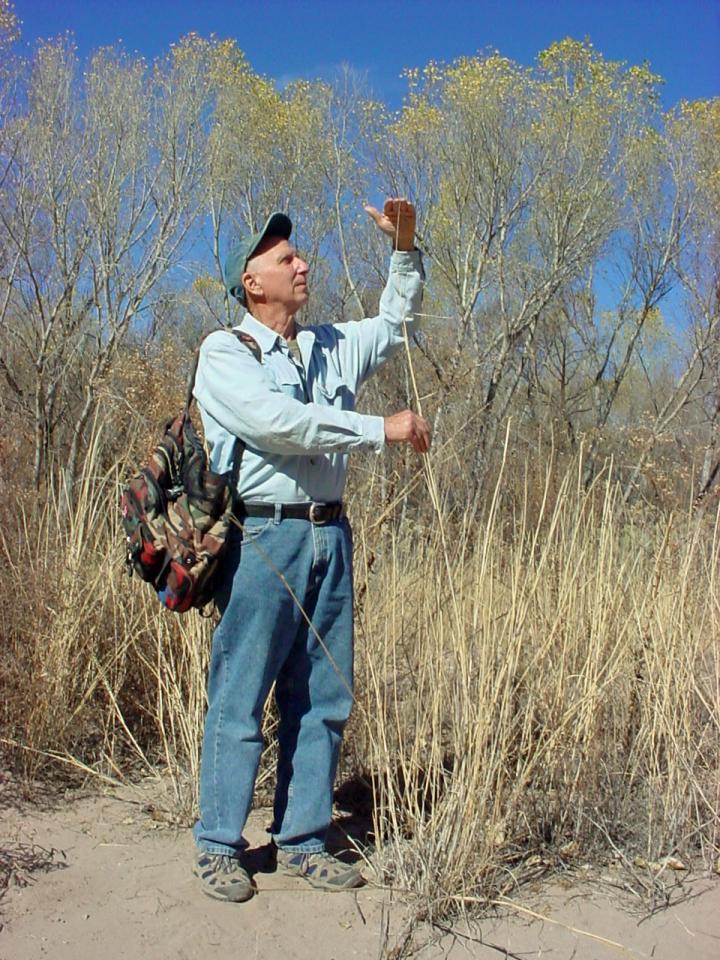|
|
|
|
Family: Poaceae
giant dropseed
|
Plants perennial; cespitose, not rhizomatous. Culms 100-200 cm, (3)4-10 mm thick near the base. Sheaths rounded below, striate, margins hairy distally, apices with conspicuous tufts of hairs, hairs to 2 mm; ligules 0.5-1.5 mm; blades 10-50 cm long, (3)4-10(13) mm wide, flat, glabrous on both surfaces, margins whitish, scabridulous. Panicles all terminal, 25-75 cm long, 1-4 cm wide, spikelike, dense, usually included in the uppermost sheath; lower nodes with 1-2(3) branches; primary branches mostly 0.5-6 cm, appressed or spreading to 30° from the rachis, spikelet-bearing to the base; secondary branches appressed; pulvini glabrous; pedicels 0.5-2 mm, appressed. Spikelets 2.5-3.5(4) mm, whitish to plumbeous. Glumes unequal, narrowly lanceolate, membranous, prominently keeled; lower glumes 0.6-2 mm; upper glumes 2-3.5(4) mm, subequal to the lemmas; lemmas 2.5-3.5(4) mm, linear-lanceolate, membranous, glabrous, acute; paleas 2.4-3.4(3.8) mm, linear-lanceolate, membranous, glabrous; anthers 0.6-1 mm, yellowish. Fruits 0.8-1.7 mm, ellipsoid, light yellowish-brown, sometimes translucent. 2n = 36. Sporobolus giganteus grows in sand dunes and sandy areas along rivers and roadsides, at elevations from 100-1830 m. Its range extends from the southwestern United States into northern Mexico. FNA 2003 Common Name: giant dropseed Duration: Perennial Nativity: Native Lifeform: Graminoid General: Large, robust, caespitose perennial grass; not rhizomatous; culms 100-200 cm, 3-10 mm thick near the base. Vegetative: Sheaths rounded below, striate, margins hairy distally, apices with conspicuous tufts of hairs, the hairs to 2 mm; ligules 0.5-1.5 mm; blades 10-50 cm long, 3-13 mm wide, flat, glabrous on both surfaces, margins whitish, scabridulous. Inflorescence: Panicles all terminal, spikelike, dense, 25-75 cm long, 1-4 cm wide, usually included in the uppermost sheath; primary branches appressed or spreading to 30- from the rachis, spikelet-bearing to the base; secondary branches appressed; pedicels 0.5-2 mm, appressed; spikelets 3-4 mm, 1-flowered; glumes unequal, narrowly lanceolate, membranous, prominently keeled, subequal to the lemmas; lemmas 3-4 mm, linear-lanceolate, membranous, glabrous, acute. Ecology: Found in sand dunes and sandy areas along rivers and roadsides; below 6,000 ft (1829 m); flowers July-October. Distribution: s UT, AZ, CO, NM, TX, OK; south to s MEX. Notes: Sporobolus species have single-seeded spikelets with unequal glumes, no awns, and most often small seeds which readily fall after maturing hence the common name "dropseed." Giant dropseed is distinguished by being a robust perennial bunchgrass, often reaching 1-2 m tall, with thick bases and tufts of white hairs at the apex of the leaf sheaths; and a tall narrow terminal inflorescence, loosely to tightly contracted, 1- 4 cm wide. Ethnobotany: Seeds were made into meal for bread, for mush, and the stiff stems were made into a brush to clean cacti spines. Editor: FSCoburn 2015, AHazelton 2015 Etymology: Sporobolus is Greek for "seed-caster" while -giganteus- refers to its giant size relative to other species in the genus. |


